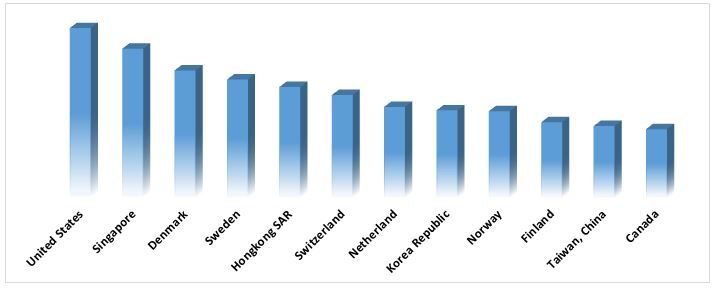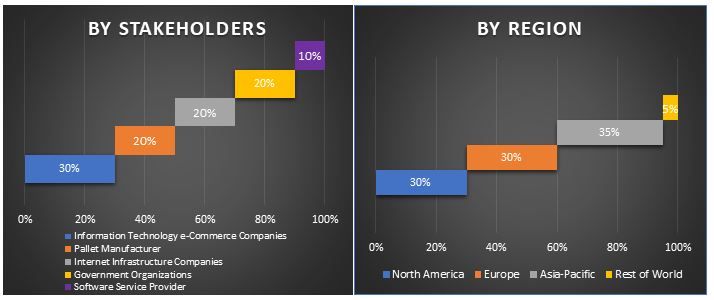- Home
- About Us
- Industry
- Services
- Reading
- Contact Us
Digital Logistics Market: Current Analysis and Forecast (2021-2027)
Emphasis on Type (Inventory Management, Warehouse Management System, Fleet Management, Others); Organization Size (Large Enterprises, Small-Medium Enterprises); Deployment Mode (Cloud, On-Premises); Industry Verticals (Retail, Automotive, Pharmaceuticals, Food & Beverage, Oil & Gas); and Region & Country

Technological innovation and changing customer behavior are key components for digital logistics. The advancement of technology and communication in logistics leads to reduce operating costs, enhances overall efficiency, improves supply chain, and provides customer-centric solutions. Transportation service providers such as carriers, third-party logistics providers, and freight forwarders have traditionally composed a big market for logistics IT. According to a survey in 2020, three industries play a huge role in the market as transportation services: manufacturing (81%), wholesale (81%), and retail (80%). E-marketplaces for transportation and logistics services arise, with tremendous success targeting certain industry sectors. Start-ups in the freight, parcel, or last-mile arena that started as standalone apps have grown into separate platforms that aggregate access to shippers and carriers.
In 2020, the e-commerce market is not only thriving but it’s expected to more than 95% of all purchases to be conducted via e-commerce by 2040. It is expected that mobile commerce will take a market share of 73% e-commerce by the end of 2021. There are over 2 billion digital buyers in the world, which further boosts the logistics demand. The major players such as Tech Mahindra (India), SAP SE (Germany), Oracle Corporation (U.S.), International Business Machines Corporation (U.S.), etc., are the leading providers of digital logistics solutions across the world. Cainiao, a Chinese logistics company developed a digitalized customs clearance system which, it claims, can process a massive amount of information such as orders and payments to digitalized data, and it has launched its first direct cargo flight between Zhengzhou in China and Budapest in Hungary.
Worldwide Digital Competitiveness Rankings, By Country
IBM, Oracle, SAP, Intel, Infosys, HCL Technologies, Samsung SDS, Cloud Logistics, Digi Logistics, and Tech Mahindra are some of the prominent players operating in the digital logistics market. Several M&As along with partnerships have been undertaken by these players to facilitate customers with hi-tech and innovative products/solutions.
Insights Presented in the Report
“Amongst Type, Fleet management segment is anticipated to dominate the market during the analyzed period”
Based on type, the digital logistics market is bifurcated into inventory management, warehouse management system, fleet management, and others. In 2020, the fleet management segment accounted for a maximum share in terms of revenue.
“Amongst Organization size, Large Enterprises segment is anticipated and dominate in the market”
Based on organization size, the digital logistics market is fragmented into large enterprises and small-medium enterprises. In 2020, the large enterprises segment accounted for the largest market share in terms of revenue and is expected to remain dominant during the analyzed period.
“Amongst Deployment mode, Cloud segment dominated the market during the forecast period”
Based on deployment mode, the digital logistics market is fragmented into cloud and on-premises. In 2020, the cloud segment accounted for more than XX% revenue share.
“Retail, Automotive, Pharmaceuticals, Food & Beverage, and Oil & Gas were the major verticals for Digital logistics”
Based on industry verticals, the retail segment constitutes the majority of the market share and is expected to remain dominant over the analyzed period. ?
“North America represents the largest regional market for Digital Logistics”
For a better understanding of the market dynamics of the digital logistics market, a detailed analysis was conducted for different regions across the globe including North America (U.S, Canada, and the Rest of North America), Europe (Germany, France, Italy, United Kingdom, Spain, and Rest of Europe), Asia-Pacific (China, Japan, India, Australia, and Rest of APAC) and Rest of the World. North America dominated the market and grabbed around XX% market share owing to a larger customer base and advanced logistics infrastructure.
Reasons to buy this report:
- The study includes market sizing and forecasting analysis validated by authenticated key industry experts
- The report presents a quick review of overall industry performance at one glance
- The report covers an in-depth analysis of prominent industry peers with a primary focus on key business financials, product portfolio, expansion strategies, and recent developments
- Detailed examination of drivers, restraints, key trends, and opportunities prevailing in the industry
- The study comprehensively covers the market across different segments
- Deep dive regional level analysis of the industry
Customization Options:
Digital Logistics Market can further be customized as per the requirement or any other market segment. Besides this, UMI understands that you may have your own business needs, hence feel free to connect with us to get a report that completely suits your requirements.
Table of Content
Analyzing the historical market, estimation of the current market, and forecasting the future market of Digital Logistics were the three major steps undertaken to create and analyze the adoption of digital logistics among large enterprises and small-medium enterprise’s organizational size across the globe. Exhaustive secondary research was conducted to collect the historical market numbers and estimate the current market size. Secondly, to validate these insights, numerous findings and assumptions were taken into consideration. Moreover, exhaustive primary interviews were conducted, with industry experts across the value chain of digital logistics. Post assumption and validation of market numbers through primary interviews, we employed a bottom-up/top-down approach to forecast the complete market size to 2027. Thereafter, market breakdown and data triangulation methods were adopted to estimate and analyze the market size of segments and sub-segments the industry pertains to. Detailed methodology is explained below:
Analysis of Historical Market Size
Step 1: In-Depth Study of Secondary Sources:
Detailed secondary study was conducted to obtain the historical market size of the digital logistics through company internal sources such as annual report & financial statements, performance presentations, press releases, etc., and external sources including journals, news & articles, government publications, competitor publications, sector reports, third-party database, and other credible publications.
Step 2: Market Segmentation:
After obtaining the historical market size of the digital logistics, we conducted a detailed secondary analysis to gather current and future market insights and share for different segments & sub-segments for major regions. Major segments included in the report include type, organization size, deployment mode, verticals, and region. Further country-level analyses were conducted to evaluate the overall demand for digital logistics in the specified country/region.
Step 3: Factor Analysis:
After acquiring the historical market size of different segments and sub-segments, we conducted a detailed factor analysis to estimate the current market size of digital logistics. Further, we conducted factor analysis using dependent and independent variables such as the rising online shopping, penetration of internet users, and adoption of cloud-based technology. A thorough analysis was conducted for demand and supply-side scenarios considering top partnerships, merger and acquisition, business expansion, and product launches in the digital logistics industry across the globe.
Current Market Size Estimate & Forecast
Current Market Sizing: Based on actionable insights from the above 3 steps, we arrived at the current market size, key players in the digital logistics market, and market shares of each segment. All the required percentage shares split, and market breakdowns were determined using the above-mentioned secondary approach and were verified through primary interviews.
Estimation & Forecasting: For market estimation and forecast, weights were assigned to different factors including drivers & trends, restraints, and opportunities available for the stakeholders. After analyzing these factors, relevant forecasting techniques i.e. bottom-up/top-down approach was applied to arrive at the market forecast by 2027 for different segments and subsegments across the major markets globally. The research methodology adopted to estimate the market size encompasses:
- The industry’s market size, in terms of value (USD) and the growth rate of digital logistics market across major markets domestically
- All percentage shares, splits, and breakdowns of market segments and sub-segments
- Key players in the digital logistics market in terms of services offered. Also, the growth strategies adopted by these players to compete in the fast-growing market
Market Size and Share Validation
Primary Research: In-depth interviews were conducted with the Key Opinion Leaders (KOLs) including Top Level Executives (CXO/VPs, Sales Head, Marketing Head, Operational Head, and Regional Head, Country Head, etc.) across major regions. Primary research findings were then summarized, and statistical analysis was performed to prove the stated hypothesis. Inputs from primary research were consolidated with secondary findings, hence turning information into actionable insights.
Split of Primary Participants in Different Regions
Market Engineering
Data triangulation technique was employed to complete the overall market estimation and to arrive at precise statistical numbers of each segment and sub-segment the digital logistics market pertains to. Data was split into several segments & sub-segments post studying various parameters and trends in the areas of type, organizational size, deployment mode, verticals, and region.
Main Objective of the Digital Logistics Market Study
The current & future market trends of digital logistics were pinpointed in the study. Investors can gain strategic insights to base their discretion for investments from the qualitative and quantitative analysis performed in the study. Current and future market trends would determine the overall attractiveness of the market at a regional level, providing a platform for the industrial participant to exploit the untapped market to benefit as a first-mover advantage. Other quantitative goals of the studies include:
- Analyze the current and forecast market size of digital logistics in terms of value (US$). Also, analyze the current and forecast market size of different segments and sub-segments
- Segments in the study include areas of type, organizational size, deployment mode, and industry verticals
- Define and analysis of the regulatory framework for the digital logistics industry
- Analyze the value chain involved with the presence of various intermediaries, along with analyzing customer and competitor behaviors of the industry
- Analyze the current and forecast market size of the digital logistics market for the major regions including North America (United States, Canada and Rest of North America), Europe (United Kingdom, Germany, France, Itay, Spain and Rest of Europe), Asia-Pacific (China, Japan, India, Australia and Rest of Asia-Pacific), and Rest of World
- Company profiles of the digital logistics market and the growth strategies adopted by the market players to sustain in the fast-growing market
- Deep dive regional level analysis of the industry
Related Reports
Customers who bought this item also bought












